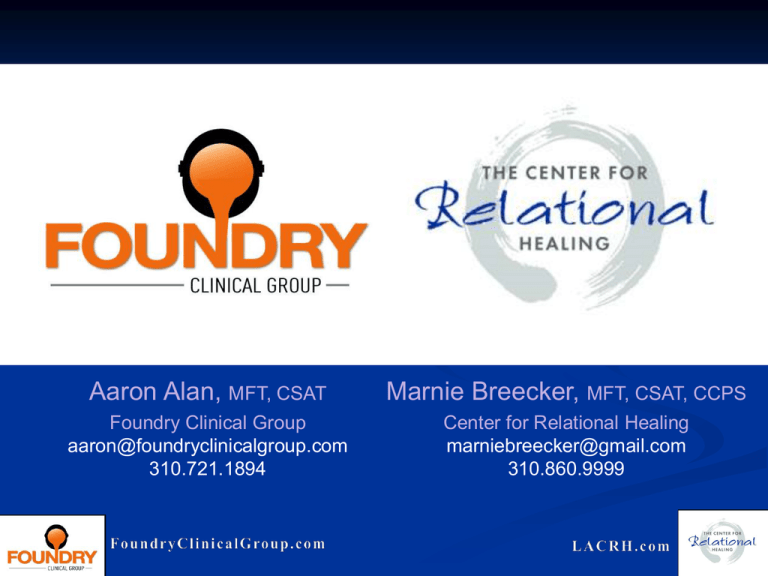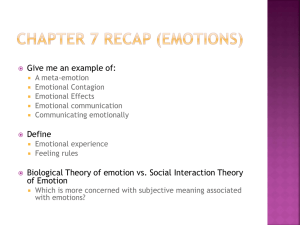
Aaron Alan, MFT, CSAT
Marnie Breecker, MFT, CSAT, CCPS
Foundry Clinical Group
aaron@foundryclinicalgroup.com
310.721.1894
Center for Relational Healing
marniebreecker@gmail.com
310.860.9999
Facilitating a Formal Disclosure
Aaron Alan, MFT, CSAT
Marnie Breecker, MFT, CSAT, CCPS
Foundry Clinical Group
aaron@foundryclinicalgroup.com
310.721.1894
Center for Relational Healing
marniebreecker@gmail.com
310.860.9999
Why a CEU on Disclosure?
To give therapists a common frame
Stress importance of working systemically
Purpose today is to give info on process
rather than debate validity
(that’s a whole other conversation!)
Defining Terms
Addict: person disclosing secrets/lies
Partner: person receiving information
Discovery: when partner first learns of
sexual acting out
Disclosure: the formal process of sharing
information about secrets & lies related to
sexual acting out
What Is Disclosure?
The transfer of information from one party
to another
NOT an amends, but is often considered a
piece of the amends to a partner
Disclosure is done only with primary
relationship
Is a part of healing relational trauma
Is highly stressful for everyone
Purpose of Disclosure
To facilitate healing of the trauma created by the
secrets & lies
Rebuilding trust and intimacy in rx
(Re)establish equality in the relational dynamic
To give partners the truth about their relationship
and the person with which they have chosen to
share their life.
Shame reduction for the addict, surrender secrets
“We’re only as sick as our secrets”
Not All Therapists Agree
Some clinicians advocate against
Disclosure
Consider it harmful to rx
Shaming for addict
Traumatizing for partner
Creates power differential
Differ in methodology/protocol
Differ in content
Voluntary
Both clients must agree to participate
Either one can choose not to participate
Therapists should tread lightly in
advocating for disclosure
Outcome cannot be guaranteed
The Frame Is Key
Structure/boundaries
Carefully planned
Therapist guided
Done in session not “over kitchen table”
Staggered Disclosure
When pieces of information come out at
different times (“drips & drabs”)
Partners often wonder when “other shoe
will drop”
Message is “there’s always more”
Perpetuates trauma for partner
Similar to compulsively picking a wound
“But S/he Knows Everything”
Formal Disclosures are completed even
when a partner has been “told everything”
because information previously revealed
can often be incomplete; however well
intended
Don’t know what they don’t know
Healing/catharsis in process
When Is Disclosure Done?
As soon as reasonably possible
Addict is stabilized and is “sexually sober”
After partner has begun therapy and is
stabilized
Contraindications
When divorce is imminent or relationship is ending*
Either person is not emotionally stable
Unaddressed psychiatric issues
Unaddressed CD/substance abuse
One of the treating therapists is NOT on board
Partner has no therapist and/or deficit of support
Partner is in acute state of trauma
Addict is continuing to act out / not in recovery
Preparation
Pre-Disclosure
Informed consent (potential pros and cons)
Disclosure worksheets
Informing of Disclosure timeline
Cessation of “detective work” and disclosurerelated questions
No sexual contact
From time Disclosure is scheduled through PostDisclosure follow-up session
Safety planning for day of Disclosure
Informed Consent
Potential benefits
Rebuilding trust, intimacy
End of denial
Validation that partner is not crazy
Partner receiving the information to make
decisions about future
Establishing equality
Shame reduction for addict
Informed Consent
Potential drawbacks
Increased conflict in relationship
Intrusive thoughts for partner & other trauma
sx /retraumatization
Anger/rage from partner
Misuse of disclosure in a legal proceeding
Destructive compensatory bx (addictions,
compulsions)
Emotional dysregulation for both people
Immediately Disclosed Info
Imminent risk of harm or actual harm
e.g., safety, legal problems
Sexually transmitted infections and other related
health issues
Imminent risk to reputation and/or social status
Imminent risk or actual harm to household/family
Imminent financial impact on household/family
Consultation
Confer with all members of treatment team
Therapist for partner/addict
Couples therapist (if applicable)
Psychiatrist (if applicable)
Group therapist (if applicable)
Partner’s Preparation
Managing of expectations
Setting realistic expectations
Psychoeducation about sex addiction
Disclosure is voluntary
Informed Consent given
Exploration of information already known
Exploration what information partner wishes to
receive and NOT receive
Partner’s Preparation (cont’d)
Boundary setting (no detective work, no questions,
stopping sexual contact with addict, etc.)
Self-care planning for before, during & after
Partners can request certain items/information
deleted or withheld from the Disclosure, if they
so choose
Use worksheets
Addict’s Preparation
Education about denial and purpose of Disclosure
Help in presenting information with ownership and
responsibility-taking
Understanding importance of empathy for partner
Disclosure is voluntary
Informed Consent given
Addict’s Preparation (cont’d)
Education and prep for Disclosure process, format
and structure
Boundary setting (no sex with partner, etc.)
Incorporate partner’s personal parameters into
Disclosure
Self-care planning for before, during & after
Disclosure vs. 9th Step
“Made direct amends to such people wherever
possible, except when to do so would injure
them or others.”
Disclosure is part of treatment
Amends is part of recovery
Treatment addresses the relationship/system
Recovery addresses the individual
Pain vs. Injury
Pain is experienced when informed
Injury occurred when acting out occurred
Disclosure vs. 9th Step
Like resetting a broken bone – yes, it’s painful!
Disclosure = information transfer
Accounting of the damage
Necessary for a complete amends to be made
Otherwise, partner cannot fully understand what
apology is for
Amends = repairing the damage
Information vs. taking responsibility and
accountability
Content of Disclosure
Sobriety Date
List of general addictive behaviors
List of specific addictive behaviors, including:
Time frames of acting out (dates and/or events)
Frequency/duration of acting out
Places/locations of acting out that are relevant
Money spent on acting out
Behaviors that have involved another person/people
Content of Disclosure (cont’d)
Exact # of sexual partners (or best estimate if
exact number is incalculable)
Identity of any acting-out partner that your
partner may personally know
Identity of any friends/family members who may
already be aware of this problem
Content of Disclosure (cont’d)
Information starting from start of relationship
In some cases, partners may prefer to receive
information spanning the addict’s adult life, which can
be helpful to contextualize and depersonalize the
addictive behaviors. In these cases, info preceding
the relationship is general rather than specific.
Any specific lies told in service of the addiction
are clarified and the truth is given
Structure of Disclosure
Session
Therapist Preamble
What today looks like
The purpose of Disclosure
To have a clean slate
To stop staggered Disclosure (drips & drabs)
There may be info revealed that contradicts what
addict previously swore was the truth
Sometimes addicts hold on to info (not to be
duplicitous), but after Discovery addicts gave answer
that they feel locked into or truth was soft-pedaled
This is opportunity to come clean about that
Therapist Preamble (cont’d)
It’s OK to have feelings about hearing
contradictory information (normalize this!)
Addict will read their Disclosure, giving info, no
excuses, apology or rationale for behavior
Recommend no physical contact
OK to ask clarifying questions (timing, etc.)
If question is more in-depth, we may ask that the
question be parked so it can be discussed with
therapist and asked later (post-Disclosure)
Therapist Preamble (cont’d)
Disclosure can be read twice
Partner can take notes
Partner leads the pacing
“foot on gas and brake”
OK to pause if partner needs to leave room
Partner can end Disclosure at any point
Are you both ready?
Working Systemically &
Advocating for the Partner
Advocating for the Partner
Advocating for your client with a therapist you don’t know
and/or has differing opinions from you regarding
Disclosure can be frustrating and extremely challenging
It is important to focus only on doing what is in the best
interest of your client and ensuring a thorough disclosure
and safe experience for both partners
Unfortunately, there isn’t one universal Disclosure
process that is agreed upon and adopted – including
within the community of sex addiction therapists
Advocating for the Partner
If the addict’s therapist is a colleague with whom
you share similar views and approaches to
Disclosure, your task will be much easier
Being on the same page regarding the structure
and content of the disclosure in very important
When this doesn’t happen, each partner will
receive conflicting information from his/her
individual therapist, which can easily lead to
more confusion and frustration for the couple
Advocating for the Partner
The time surrounding disclosure is typically
overwhelming and emotionally excruciating and
frequently causes further rupture to the relationship
It is the therapists’ job to work together as a team to
create the safety necessary for disclosure to occur
Even the best intentioned therapists can succeed in
splitting a couple when they engage in a power struggle
over whose approach is best, as it leaves the couple
arguing over whose therapist is “right” and “wrong”
It is our responsibility to do what we can do to help our
clients heal, not exacerbate their problems
Advocating for the Partner
Having our own ideas and opinions and being reluctant
to stray from that doesn’t take into account the individual
needs of each client; such rigidity makes negotiation,
compromise and resolution nearly impossible
If two therapists working with a couple differ in their
opinions, there must be room for negotiation
Sometimes therapists get caught up in ego, pride and/or
personality conflicts and can lose sight of the goal of
Disclosure
Advocating for the Partner
All actions should be in service of relational healing
Therapists working together on a disclosure must base
their decisions and planning first on the partner’s needs,
then on the addict’s needs
It is important for therapists to manage expectations
(both their own and those of their clients), as Disclosure
does not necessarily mean that the couple will stay
together or be successful in rebuilding intimacy and trust
Advocating for the Partner
When there are different opinions among the treating
therapists, it may help to choose to work from a book
such as “Disclosing Secrets”, which can ensure that both
partners are being given the same information
Timeline for Disclosure
Once date is set, it’s imperative clts follow therapist
recommendations (esp re boundaries)
Safety planning (separate cars, 24 hrs apart, etc)
If polygraph is incorporated, it’s usu done before Disclosure
Allow 2 hrs for Disclosure session
Partner usually has a support session immediately after
Disclosure session
Follow-up session is usually 3-7 days after Disclosure
AKA “Boundaries & Consequences” session
Couples therapy often recommended at this point
Post-Disclosure Boundaries
No contact for 24 hours after Disclosure
Allows partner to absorb info
Conversations only to “news, weather & sports”
No physical contact initiated by addict
No abuse (physical or verbal)
Copy of disclosure is in partner’s therapist file for
review in session
Partner NEVER leaves with printed copy of Disclosure
Use of Polygraph
Controversial
Can be effective as a therapeutic tool: level of
‘willingness’ to go to any lengths for repair of
relationship
Not “gotcha” experience (we want addict to pass)
Is highly shaming for person taking polygraph
Is highly anxiety-provoking for person waiting on
results (partner)
Protocol for Polygraph Use
Addict’s therapist gives polygrapher 2-4 questions:
“Is your disclosure complete and accurate to the best of
your awareness/recollection?”
“Have you acted out sexually since your stated sobriety
date?”
(1-2 questions generated from partner)
Results delivered as follows:
Polygrapher
Addict’s therapist
Partner’s therapist
Addict’s therapist
Partner’s therapist
Partner
Disclosure Follow-up Session
Follow-up questions posed
Boundaries & consequences delivered
Partner uses a worksheet to assist in processing
“What I need to feel safe in the relationship is…”
“If you are unable to hold this boundary, I will take care of
myself by…”
Cause & effect rather than punative to addict
Partner reads in session to the addict
Addict SHOULD leave with a printed copy
Mistakes Commonly Made
Giving partner a print-out of the Disclosure
Allowing content to include amends, excuses
and rationale for behaviors/choices
Disclosure written as a narrative rather than
simply stating the facts
Not editing out equivocations
“probably”, “maybe”, “something like…” (sounds like
guessing)
Better to use “approximately”
Mistakes Commonly Made
Not editing out lascivious content
Failing to interrupt the asking of lascivious
and/or punitive questions
Better to use clinical terminology
“How large were her breasts?”
“How could you do this if you loved me?”
Including sexual template info in Disclosure
This is a violation against the addict
Mistakes Commonly Made
Allowing “victim-stance” statements in Disclosure
Not working systemically
“I paid for sex because you rejected me that night”
Trying to manage Disclosure by self
Not requiring the partner work with a therapist through
his process – even if it’s just temporary
Being too rigid about the process
Holding dates as more important than process /
safety
Resources
Association of Partners of Sex Addicts
Trauma Specialists (APSATS)
Non-profit for training/certifying therapists
Foundry Clinical Group
www.foundryclinicalgroup.com
The Center for Relational Healing
www.lacrh.com
“Disclosing Secrets” by Jennifer Schneider, MD
Facilitating a Formal Disclosure
Aaron Alan, MFT, CSAT
Marnie Breecker, MFT, CSAT, CCPS
Foundry Clinical Group
aaron@foundryclinicalgroup.com
310.721.1894
Center for Relational Healing
marniebreecker@gmail.com
310.860.9999
Aaron Alan, MFT, CSAT
Marnie Breecker, MFT, CSAT, CCPS
Foundry Clinical Group
aaron@foundryclinicalgroup.com
310.721.1894
Center for Relational Healing
marniebreecker@gmail.com
310.860.9999






